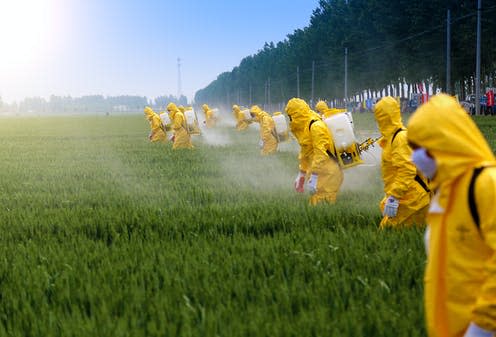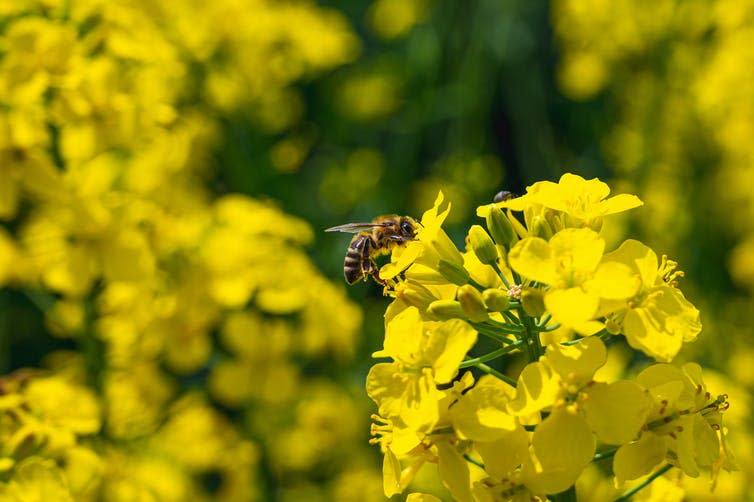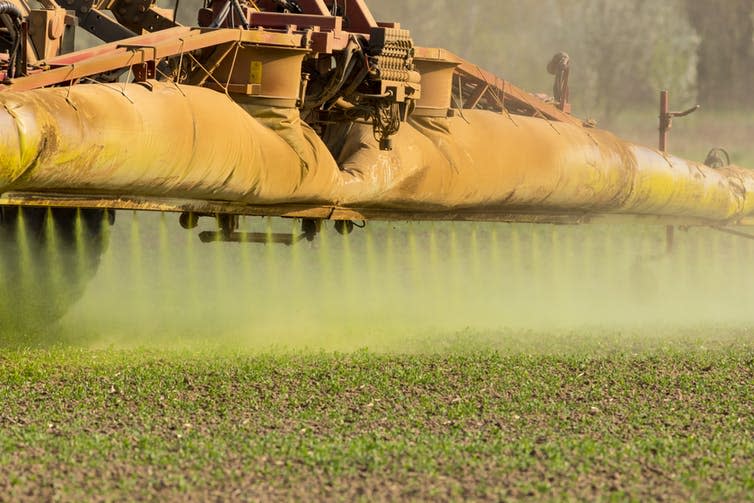Pesticides: interactions between agrochemicals increase their harm to bees

A doctor will always ask if you are on any other medication before they write you a prescription. This is because pharmaceuticals can interact with each other and potentially disrupt the treatment, or even harm the patient. But when agrochemicals, such as pesticides, are licensed for use on farms, little attention is paid to how they interact with one another, and so their environmental impact is underestimated.
Bees are important pollinators of both crops and wildflowers. It’s estimated that 35% of crops are dependent on pollination, but the environments bees find themselves in today are increasingly hostile. In the UK, it’s estimated that 97% of semi-natural grasslands, habitat filled with the nectar-rich wildflowers bees visit for food, have been lost. Meanwhile, the commercial trade in honeybees for their pollination services has increased the prevalence of harmful parasites and, as if this was not already enough, bees are also routinely exposed to numerous different agrochemicals.
We analysed data gathered in scientific studies from the last two decades and found that when bees are exposed to a combination of pesticides, parasites and poor nutrition, the negative impact of each is exacerbated. We say that the cumulative effect of all these things is synergistic, meaning that the number of bees that are killed is more than we would predict if the negative effects were merely added together.

When bees were exposed to multiple agrochemicals, the effects were worse. When we consider the prevalence of these substances in the environment, the picture begins to look very worrying.
Pesticide regulation and pollinators
Crops are rarely ever treated with just one chemical. Insecticides control insect pests, such as aphids. Herbicides, such as glyphosate, kill unwanted weeds, and fungicides are used to control moulds such as mildew. Crops will often be treated with different agrochemical combinations repeatedly throughout the year.
Many agrochemicals, such as neonicotinoids, are systemic, meaning they accumulate in the environment over several months, and in some cases years. It is perhaps not surprising then that honeybee colonies across the US have on average six different agrochemicals present in their wax, with one hive contaminated with 39. It’s not just honeybees which are at risk, though: wild bees such as bumblebees are also routinely exposed.
For pollinating insects, exposure to multiple agrochemicals is the norm, not the exception. But when new agrochemicals are licensed for use by regulatory bodies, such as the US Environmental Protection Agency (EPA) or the European Food Safety Authority (EFSA), how they interact is seldom considered.
In some ways this is understandable. Thousands of different agrochemicals have been licensed for use globally and assessing how each one interacts with each other would be difficult. But commercial pesticide formulas, sold en-masse to farmers, regularly contain many different chemicals. Assessing how each of them interacts before they are licensed for use should be mandatory.

And once an agrochemical is licensed for use, regulators should continually monitor its potential harm in case pre-licensing assessments failed to detect something important. These post-licensing observations could be akin to those carried out with pharmaceuticals in humans, which would offer better protection for both wildlife and food security.
The EFSA recently announced a programme that will use mathematical models to monitor the effects of multiple potential threats, including agrochemicals, on honeybee colonies. This is encouraging, but fails to consider other wild bee species.
Understanding how the environmental impacts of human activity interact is a messy business, but it’s clearly important. A post-licensing monitoring programme for agrochemicals is laudable, but pre-licensing experiments that consider how these substance interact once in the environment must become a requirement for the environmental risk assessments of all new products. And the agrochemical companies, who profit so much from selling these products, should pick up the bill.
This article is republished from The Conversation under a Creative Commons license. Read the original article.

Harry Siviter does not work for, consult, own shares in or receive funding from any company or organisation that would benefit from this article, and has disclosed no relevant affiliations beyond their academic appointment.

 Yahoo News
Yahoo News 